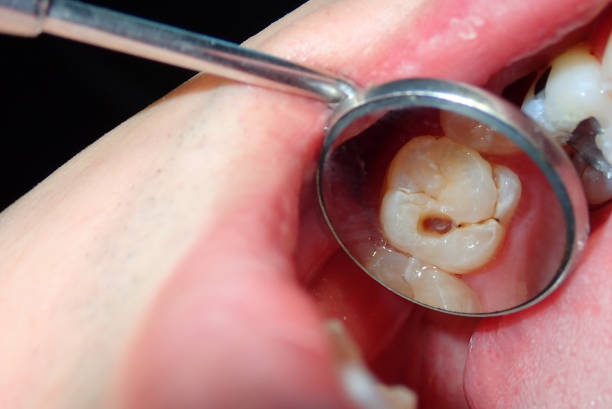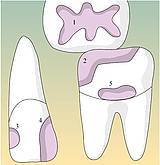Dental caries (from the Latin careo, “to be devoid“) is a degenerative disease of the hard tissues of the tooth (enamel, dentine) with a more widespread infectious basis, which originates from the surface and proceeds in depth, up to the dental pulp which can affect the teeth at any age.
This pathology is caused by the common microorganisms present in the oral cavity, mainly those adhering to the tooth in the form of bacterial plaque.
I batteri prodotti dai residui di cibo favoriscono un forte sviluppo della carie perché fermentano e producono gli acidi che, insieme alla saliva, formano la placca dentale.
If not kept under control through common oral hygiene practices, or in the case of a lowering of the immune defenses, they manage to dissolve the mineral and organic matrix that constitutes the tooth, creating cavitated lesions.
When tooth decay occurs, if not treated in time and adequately, it insinuates itself into the deeper layers of the tooth, causing hypersensitivity, intense pain, tooth loss, the presence of visible holes, and serious health problems.
The main symptom is pain, which however often appears only when the process has gone very deep, affecting the pulp organ (pulpitis).
To prevent the onset of tooth decay, daily oral hygiene and regular check-ups at the dentist are essential.

The treatment of tooth decay depends on the degree of severity.
The treatment involves the removal of the infected tissue and its replacement with suitable material (conservative dentistry), and, in the case of advanced pulp involvement, the removal of the pulp tissue and its replacement (endodontics).
The most used method is obturation, i.e. the removal of the necrotic parts and the closing of the cavity with special materials.
If the tooth has become very weakened, it can be covered with a custom-made crown that replaces the outermost part of the tooth.
The choice of filling material depends on the nature of the defect.
The development of adhesive fillings with the use of the acid-etching technique has led, in the field of obturation therapy, to the rapid development of new aesthetic bio-materials.
Until then, amalgam was used as a filling material in the area of posterior teeth.
Today, in addition to the aesthetic bio-material that restores the color and shape of the original tooth, inlays (aesthetic fillings milled with CAD / CAM technology from a single ceramic block) are also used, which allow reliable, aesthetic and long-lasting reconstructions.
When the cavity, however, reaches the pulp, it becomes necessary to devitalize the tooth, i.e. extract the pulp to replace it with the appropriate materials.
Root canal treatment, also called root canal treatment, is a necessary intervention when the cavity has reached the dental pulp, causing pain and inflammation.

The residual spaces that are created as a result of the preparation, the cavities, are divided, according to the location of the carious lesion, into five classes. This classification is important from a practical point of view for the purposes of describing the filling.
Contact us and book a free initial consultation now.
Learn more about the topic by reading our articles.

The Clinics of Excellence for Oral Surgery and Implantology.
Sanident srl – P. I. 06696930962
Copyright © 2025. All Right Reserved.